12 Things Will Decide Domes’ Future
Politicians will decide their fate, but citizens can lead the way. 12 issues are key.
The Mitchell Park Conservatory faces an uncertain future. The Show, Arid and Tropical Domes are due to reopen by fall. In January, safety concerns and closure were triggered by long-deferred structural repairs. County Executive Chris Abele now considers demolition “a realistic option.” That’s in contrast to goals established in 2006, when Scott Walker was executive, by a broad team of experts and county staff. The two-year study set out “to maintain The Domes as a jewel of the Milwaukee County Parks infrastructure” and a “must-see and must-experience destination for SE Wisconsin residents and visitors.”
In response to the tear-down talk, The Cultural Landscape Foundation of Washington, D.C., has named the Domes to its Landslide program of “nationally significant cultural landscapes and landscape features that are threatened and at-risk.” The nonprofit will monitor and advocate for the Domes from here on out.
Will the Domes remain a Milwaukee “living landmark.” or be replaced?
That will depend on 12 key factors:
1. Abele vs. County Board: As Urban Milwaukee has reported, Abele and the board have created dueling committees and processes to decide the Domes’ future. The board favors repair and preservation, while Abele is open to all options including replacing the Domes. The Abele administration has engaged urban design professional Larry Witzling, a principal of GRAEF USA, to guide a “community engagement process” to determine what to do about the Domes. It could cost as much as $30,000 and would create a “Conservatory Advisory Committee” that will include 14 to 25 members. Names of members have not been released, but according to Abele’s spokesperson Melissa Baldauff will include the parks department’s horticulture services manager, representatives of the Clarke Square Neighborhood Initiative, Friends of the Domes, Journey House, Milwaukee Public Schools, NEWaukee, Potawatomi Casino and Visit Milwaukee.
The board voted (on March 17) to establish an 11-member task force which will be the board’s parks committee chair, the District 12 supervisor, directors of parks and facilities management, the Milwaukee County Parks Advisory Commission chair, and representatives from Friends of the Domes, the historical preservation community and three other community organizations. Members will reportedly be appointed within weeks. A report is due by September 2016.
2. Public input. Public opinion could be quite influential. Meetings of the board’s task force will be public and subject to Wisconsin Open Meetings Law. They are televised if held in county hearing rooms. The county comptroller’s office will staff the task force.
Abele’s committee has so far been more mysterious. His administration said there was an unadvertised “preliminary” meeting of its Domes committee March 23; if so, that may have violated Wisconsin Open Meetings Law. Going forward, the county’s Domes page promises a public process: “there will [be] several community meetings held during and after the Steering Community’s work where the public can participate in the process. Individuals interested in connecting to this public process should contact the County Executive’s Office at 414-278-4211 or Domes@milwaukeecountywi.gov.”
As Charles A. Birnbaum, head of The Cultural Landscape Foundation puts it: “In a quest for consensus on the future of the Domes, which are likely eligible to the National Register of Historic Places, it is essential the process be open and accessible (and) that the information considered be freely shared and carefully vetted.”
3. Hard data. No current repair bids have been obtained. Best practices call for at least three independent estimates. The 2008 Show Dome report concluded that long-term restoration requires replacing its glass-and-aluminum facade. County officials say the concrete-and-steel infrastructure is sound for all three Domes. Only surface concrete is flaking. Five glass replacement options were reviewed. Four fixes would retain “the historical authenticity of the existing structure.” A January 2015 GRAEF report on all three Domes reiterated, “Because the majority of the water causing damage is coming from the glazing system, it is imperative that the glazing system be addressed if the buildings are to remain in operation and in a safe condition…” It further urged: “Because of the accelerated pace at which wet structures can deteriorate, provisions for future inspections and/or repairs should be made within the next two years.” Abele seems to be looking for data showing repair is too expensive, while the board is hoping for more optimistic scenarios.
5. Competing Visions: Abele may argue the Domes have outlived their time and it’s time for some unnamed, all-new, 21st century alternative. Preservationists will take their cue from folks like Linda Keane, a nationally recognized professor of architecture and environmental design at the School of the Art Institute of Chicago and a long-time Domes “friend.” She wrote in an email that the Domes are “an icon of Milwaukee and we have seen the city repeatedly destroy its icons.” She cited the demolished Chicago and North Western Railway depot at the lakefront (once dubbed “the most elegant passenger station in the West”), saying it could have “preserved history…if restored as a public venue and wedding site, restaurant and shops.” In addition to preserving the Domes, Keane thinks Mitchell Park could “showcase indigenous species” as a place to study plants, seeds and wildlife. She envisions collaborations with UW-Milwaukee’s conservation and environmental science program, or other institutions.
6. Champions: High-profile advocates often help save local monuments. In 1968 preservationist Jackie Kennedy Onassis resisted plans to demolish Manhattan’s Grand Central Terminal. Its eventual renovation, completed in 1998, helped revive its neighborhood. The U.S. chapter of Dococomo, which advocates for Modernist buildings and landscapes, has embraced the Domes. They join Milwaukee Preservation Alliance, Preserve Our Parks and individual advocates. Domes fan Adrienne Pierlussi recently hosted a successful fundraiser at the Sugar Maple, a craft-beer bar she owns in Bay View. If Abele’s steering committee does promote a replacement for the Domes, we may see dueling champions of different visions.
7. Shared memories. People from all walks of life in Milwaukee County recount personal stories about the Domes. They describe family visits to Show Dome spectacles, field trips, weddings, concerts, winter wanderings–and even viewing them from afar. Some talk about them as being “part of Milwaukee’s soul.” While Abele acknowledges Milwaukeeans’ “attachment” to the Domes, he philosophically told WTMJ Radio: “What’s right for the past isn’t (necessarily) right for the future…you can have great memories of the Domes and be excited for what’s next.” He told the Journal Sentinel that residents weathered demolition of the original Victorian Mitchell Park Conservatory, which was then replaced by the Domes, and would likely get over being “nostalgic” about the Domes.
8. Consensus & Coalition Building. If the Domes are to be saved, it may require local leaders, nonprofits, grass-roots networks and national advocates to build consensus. To build that consensus, Birnbaum suggests, “the historic and cultural significance of the Domes (must) be quantified and valued in the equation.”
9. Public funding. Abele frames the discussion in fiscal terms: Is it worth it to county taxpayers to spend $75 million to restore or replicate the Domes? (Some have questioned that figure, which gets up back to Factor 3 — Hard Data.) Abele has floated alternatives such razing and replacement with serviceable greenhouses (like the new Domes Annex) or an amphitheater. Is it possible that repair could gain other government (say federal) funding? That may enter into the discussion.
10. Donors. Preservation of landmarks, especially public spaces, often attracts philanthropy from individuals, foundation and corporations. When St. Louis’s Gateway Arch grounds and museum needed revitalizing, citizens mobilized to undertake the project and commissioned an internationally renowned landscape architecture firm. A nonprofit has raised nearly $380 million, mostly from private sources. The Arch opened the same year as the Domes; both are called “Modernist marvels” by Birnbaum’s group.
11. Media. A public discussion depends upon transparency and robust media coverage. Local media have done numerous stories about the Domes since they were closed indefinitely. TCLF’s naming of the Domes as a “threatened” cultural landscape has received local media attention, including CBS 58, Wisconsin Public Radio and Urban Milwaukee; and nationally from the Guardian’s U.S. edition and the influential outlet TreeHugger.com.
12. Time. Short-term fixes—wrapping structural beams with metal mesh to prevent concrete flaking—will reportedly last five years or longer. That buys time to explore long-term options and raise funds. However, this could also result in further stalling–and decay of the Domes. After all, no decisions about long-term restoration were made after the 2008 GRAEF-County team report urged immediate action. Subsequent GRAEF reports reiterated that message. But this time feels different. Ironically, by frankly raising the prospect of tearing down the Domes, Abele may help activate supporters to demand funding their repair. Time will tell.



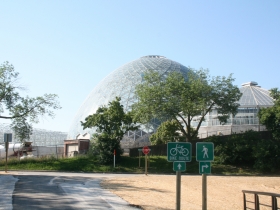
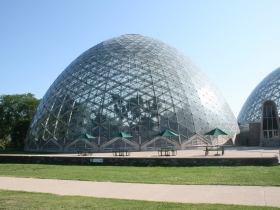
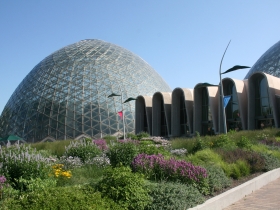
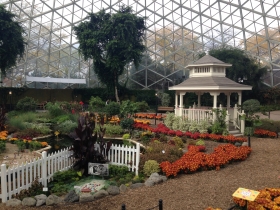
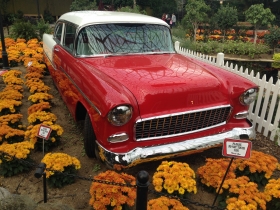
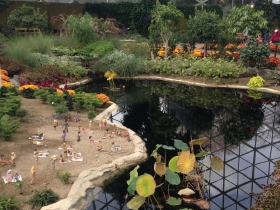

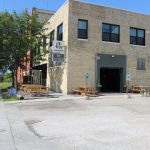

















I am hopeful the domes can be renovated and modernized a bit.
Having larger event/wedding space there, and some more interactive space for children and families would go along way to preserving the history of the domes, and bringing it-into 2016 as a multiuse public facility.
I wonder whether two of the domes could be restored and a new event/wedding space, as Nicholas suggested, could be built in place of the third dome. Perhaps it could also serve as a replacement for the show dome, with rotating seasonal floral displays. The current building layout does not lend itself to the types of activities that could help the domes remain a vital part of the community. That said, I am impressed by Sandy Folaron’s efforts to develop new activities and programs to draw people to this wonderful resource.
@Rand, the 10K-sq-ft Domes Annex that opened last fall has increased programming and rental options. It’s where they hosted the winter farmers market. And yes, Sandy Foloran has done great things with creatively programming the Domes!
http://www.jsonline.com/entertainment/arts/wild-space-dance-plans-luminous-shows-in-new-mitchell-park-greenhouse-b99594897z1-333212121.html
Couple of comments:
Item 4- Historic Register Listing. As noted on the National Parks Website “The State Historic Preservation Office notifies affected property owners and local governments and solicits public comment. If the owner (or a majority of owners for a district nomination) objects, the property cannot be listed but may be forwarded to the National Park Service for a Determination of Eligibility (DOE).” I doubt that Abele will limit his options by agreeing to a designation. Here comes another lawsuit by Lipscomb.
Item 7 – Shared Memories. Ms. Small continuously tries to tug at the emotional heartstrings to get people to forget that the water drainage design of the building failed. It’s such a great piece of engineering that it didn’t work the way it was supposed to.
Item 9 -Public Funding. Has anyone been by the courthouse? There is fencing around it because the facade is crumbling. The need for a new safety building is dire ($184 million or so)
Item 10 – Donors. There isn’t exactly a huge philanthropic population in Milwaukee. Unless there is a national figure somewhere that is in love with the Domes…..
A European style greenhouse, reoriented toward the valley with multi-use space integrating eco-friendly features like solar & geothermal is a much better option than replacing or refurbishing the Domes.
Larry Witzling, Abele’s selection as chair of his Dome committee, designed O’Donnell Park. The concept was hailed as making the lakefront accessible to downtown. We used to be able to see the lake from Wisconsin Avenue. We can’t do that now without walking well out into the fairly unparklike “park,” which is actually just a big plaza.
I don’t think someone who has an interest in new design and construction is the appropriate head of a group which is supposedly searching in an unbiased way for the answer in this matter. In fact, I think it’s pretty clear that the committee will be a sham intended to come up with what Abele wants, which is to destroy the Domes and replace them.
Chris Abele, “What’s right for the past isn’t (necessarily) right for the future…”
There he goes, still justifying his multi-milliion dollar give away and multi-million dollar taxing of local residents for his billionaire friends who own the Bucks.
@Barbara, I had not known Larry Witzling was involved in O’Donnell Park. Did he play a role in its planning? County Exec Bill O’Donnell pushed the concept way back in 1984 and a board committee approved $75K for planning (per link below). The concept for the structure and park plaza came long before a landscape architect was hired to design the actual space or an architect to design the buildings. The project was completed in 1992.
https://news.google.com/newspapers?
nid=1368&dat=19841016&id=intQAAAAIBAJ&sjid=UxIEAAAAIBAJ&pg=5790,3296856&hl=en
@ Virginia Mr. Witzling’s CV states at the third page under Environmental and Park Planning that he was involved with O’Donnell Park’s planning. https://www4dev.uwm.edu/sarup/people/faculty/upload/lawrencewitzling-cv.pdf
He certainly did, Virginia. It’s even on his CV. https://www4dev.uwm.edu/sarup/people/faculty/upload/lawrencewitzling-cv.pdf
Whether or not it was his idea in the first place, his planning/architecture group from UWM, Planning and Design Institute, did the work. I was a planning student there at the time. Didn’t work on it — other students did — but heard a lot about it. I never could understand how this was going to bring the lake closer to downtown. It obstructs the view.
Anyway, my point is, if Abele wanted to preserve the Domes he’d appoint an historic preservation professional to head up the effort. If he was really unbiased in the matter, he’d appoint someone who was not a stakeholder on either side.
The architect for O’Donnell Park was Jordy Miller, see my story here: http://urbanmilwaukee.com/2014/10/30/murphys-law-the-tragedy-of-odonnell-park/
Witzling’s firm must have done the design for the plaza (I really can’t call it a park). I only remember a lot of talk about how they were designing O’Donnell Park.
Bruce, I’m finding that Miller’s firm was fired in October, 1987 after “defects such a cracks in parking-garage beams” were found during construction. It’s possible that Witzling’s firm took over at that point.
https://news.google.com/newspapers?nid=1368&dat=19920127&id=qoZQAAAAIBAJ&sjid=1hIEAAAAIBAJ&pg=4658,5404802&hl=en
Of course, we’re getting pretty far from the Domes issue, but it’s interesting nonetheless.
James & Barbara, thanks for the links and sharing the history. And to Bruce for refreshing our memory about O’Donnell’s architectural and political saga.
The landscape architect of record was Dennis Buettner, also known for his work for Villa Terrace. I wonder how much say he had about how the plaza sits on the site. Some landscape architects are brought in early on but often they are asked to “prettify” an exterior space already defined by the architect. The lovely paving patterns, seating walls and pergolas are usually overlooked because people dislike the site layout (and some don’t even acknowledge the very green upper garden). Also, the county has not programmed any events there in a decade, as opposed to weekly events at Cathedral Square.
Jeremy, re: a historic register listing, might that come before the county board? Then, if approved, Chris Abele could either endorse or veto it. In any case, as you note, public comment would be required.
Another factor that could have been noted is input by South Side neighbors, businesses and nonprofits, esp. Clarke Square, MV, UEC, Hank Aaron Trail. They could play a big role in any outcome.
Barbara, yes Miller’s firm was fired, but by then the place had been designed and had the construction defects that led decades later to disaster. It was Miller that sold the idea this structure wouldn’t block the view of the lakefront. I hate to see the comments section became a place to pick on people based on incomplete info rather than hard reporting.
Bruce, I hope you don’t think I’m picking on Larry Witzling here. I know he’s done some good work around the city. But I was actually at UWM’s School of Architecture and Urban Planning, where the Planning and Design Institute was located, and all I heard from people who were involved there was that O’Donnell Park was going to bring Downtown to the lake. I distinctly recall asking how that was supposed to work. So whether PDI originated that idea or not, they were fully enthusiastic about it.
As to historic register listings, a City listing could be pursued as well. As I understand it, because the property is government owned, owner approval would not be necessary, and while proceedings were underway the structures could not be demolished. Nor could they be demolished after City historic designation was given.
Between the Bucks Arena and Live Block, NML Tower, and Lakefront Gateway, a number of national architectural and landscape architecture firms are working on MKE projects or have submitted designs. This might be an opportune time for a design competition as to creating an ecological / horticultural destination which unifies the Urban Ecological Center, Three Bridges, and The Domes/Mitchell Park. Seeing the possibilities might help in deciding what is to be done.
@Virginia To my knowledge the county doesn’t program any events at Cathedral Square. It is the East Town Association that programs most of the events at Cathedral Square
James, if the aim is to improve the existing Domes, an architectural competition would be good. But if the aim is to gin up enthusiasm for tearing down the Domes, I think it would be counterproductive, to put it mildly. Opening an architectural competition to replace the Domes is a tacit announcement that the decision has already been made to do so.
Thanks, Dave. I did know that others program CS events as well as those in many parks (with some co-sponsored by the county). However, a county audit of O’Donnell noted that not having any programmed events, by whomever, was a missed opportunity in maximizing this public asset.
Of course, MAM has pledged to begin programming it. That will benefit the public and MAM and increase economic activity. Although design of public spaces is relevant, both active and passive programming, including with beer gardens, mobile vendors and such, is just as crucial to their success. The Domes’ recent diverse programming is a case in point.
Domes ar beautiful, poorly promoted, merchandised. Great attraction needs a change like Cudahy took over the Pabst.
@ Barbara I was suggesting a competition encompassing both alternatives, together with a cost benefit analysis between repair and expand or replace, and then public voice and input as to which alternative is chosen. Right now, the public is not being allowed to participate in the decision making. A public design competition and cost/benefit analysis would result in more transparency.
James, I do agree that more transparency is needed. I’ve just seen too many projects that nobody wanted so architects were hired to glitz them up. Suddenly funding appears for the new alternative which the public still doesn’t much care about. Since it’s sounding like Abele doesn’t value the Domes, I’d be very wary of an “all aspects” study being designed to accomplish just that.
Barbara & James: St. Louis did a national design competition to expand and upgrade the Gateway Arch grounds, with Michael Van Valkenburgh winning. It sounds like they reached a clear consensus on project goals before then, with buy-in from various entities.
http://www.cityarchriver.org/about-the-project/process/
WCD: good point re: promotion. On Visit Milwaukee, you have to dig deep to find the Domes mentioned. That’s partly because attractions pay for strong placement–and the parks dept. budget is surely tight. Except that taxes also fund Visit Milwaukee and some of that could possibly be used to promote amenities such as the Domes and other parks (with clear ways to find them). That would benefit tourists seeking affordable destinations as well as the parks. Also, the Domes were formerly often presented as a visual symbol of MKE; now it’s mostly the Calatrava.
http://visitmilwaukee.org/
I am amazed by the unqualified support for the idea The Domes is some great building that needs to saved. I always thought it was a hackneyed oddity, more architectural kitsch than anything else.
Is the support of the Domes overly influenced by anti-Abele leftist sentiment? Why is this not an opportunity to do something better, especially given what we have learned about sustainable architecture and landscaping since they were built.
Tom, it’s true I didn’t vote for Abele, but this was the reason I didn’t. My support for the Domes is not “unqualified.” My main concern is that the public planning juggernaut will take over and shout down any real possibility of historic preservation. Milwaukee was fortunate not to be taken over by the midcentury public building boom that destroyed wonderful older buildings in so many cities. Now that there’s more money in the area, we need to be especially vigilant about protecting our historic structures. Historic structures are a part of our shared heritage, even if some people don’t like them. “Better” is a subjective term.
I am also especially concerned with the privatization champions’ strategy of allowing public structures to decay until an argument can be made for privatizing them. I am concerned for our parks system as a whole.
Chris Abele has announced county staff and Graef will lead a public input session Sat, 4/30, 11-1:30 pm in Domes lobby. Show Dome will open Friday with complimentary admission.
http://urbanmilwaukee.com/pressrelease/milwaukee-county-executive-chris-abele-announces-updates-on-domes/
The domes are not beyond their useful life, it drives me crazy when people who want to demolish them say that. Let’s be clear, the domes are severely damaged by not acting on known maintenance issues regarding the drainage system on the dome framing system.
Building new green houses just to showcase new technologies will be a waste of money as these technologies will be common place soon. The structures and their designs are unique in their time and are truly historical treasures that we must preserve and repair the damage we have done to them. In addition, we need to hold our politicians responsible for their inaction. They may have known sooner, but even as of 2008 they knew the drainage system needed to be cleaned/cleared every so often so the water didn’t continue to damage the building. Yet they did nothing.
My family loves the Domes. They are wonderful. We visited them regularly before they closed for repairs. Our kids have a blast there and never get sick of them. Plus the exhibits in the show dome, like the recent train show with mock classic movie posters, are almost always fun and worth seeing. I know we’d miss the Domes if they were gone for good. That would be a real loss.
AG: The filtration system is one cause of leaks but the 2008 Domes report says the leaks in the glass façade are even more crucial. About 25 percent of the glass panels have since been replaced through insurance money following the Falk explosion. But that still leaves most of the old glass and framing, which is allowing water to seep in.
“Useful life” can be a confusing term (it’s commonly used in defining depreciation). Unlike cars, which eventually are deemed too old to be reliably “useful” despite repairs (except the rare “classic”), buildings are commonly restored and get a new lease on life.
“Service life” is perhaps more appropriate, as applied to specific products used in construction, not the building itself. Roofs and windows have predictable service lives. The overall expected life of any building is subject to many variables. The Domes’ windows, which serve as its roof, have reached the end of their service life. Replacing glass and frames with updated-technology glass would seal the building and make it more efficient.
https://en.wikipedia.org/wiki/Service_life
We love Domes have visited often. Poorly run need some imaginative people like those that took over Pabst. l
Lease them for $1 and let some\ good managers/promoters run them as a great attraction.
if Abele wants to do something new, it would take ten years, look at the trolley.
Dumb idea.
WCD: Some nonprofit entity could offer to manage the Domes. However, the Pabst was taken over by a foundation AFTER it was restored through taxpayer funds.
It’s not clear that Abele wants to build anything new. But he may work hard to make the case that the county simply cannot afford the Domes (or any other parks/culture attractions that require capiital upkeep). The Domes will continue to leak and deteriorate and then demolition will seem like the only option, even if they are replaced by scorched earth.
Abele keeps trying to divest of as many county assets as possible and to subsidize primarily private projects/playgrounds such as the Bucks Arena, the Couture, etc., geared to upscale users. Sure, the Domes have mass appeal, but some doubt that we should we worry about the masses or an attraction in a primarily Hispanic neighborhood. Abele called them McDonalds-y.
Without dedicated funding, it’s true that we cannot afford to maintain any parks, the zoo, the Marcus Center, you name it. If MKE truly wants to stay competitive with Chicago and MPLS we will have to invest in quality-of-life infrastructure like those cities do. Until we do, the downward spiral will continue.
Dedicated funding is a joke, never “hoppen”. No one in state trusts Milwaukee to do anything since the first sales tax increase, became a joke. Milwaukee county govt, MMSD, are considered giant albatrosses for state. I have worked at state level for 50 years and they will “nevah” vote anymore taxes for Milwaukee. Public employees in Milwaukee are way over paid compared to out state. That is where money goes. Domes are great asset. You do not tear down a good asset for something that might happen 10-15 years from now. Domes are year round, if promoted well,would draw well. Bucks 50 or so dates per year? Look how fast Milwaukee moves. We wasted hundreds of millions of dollars for useless flood control on County grounds and important things go wanting. State legislators have told me that many times.